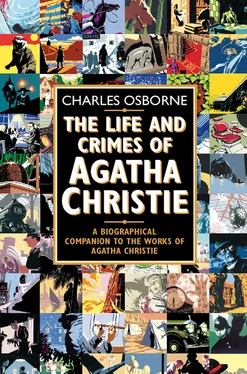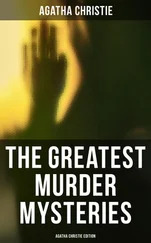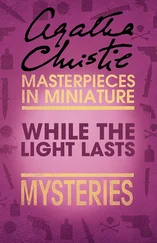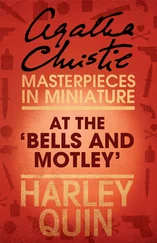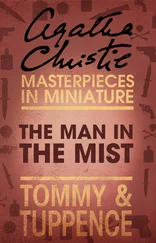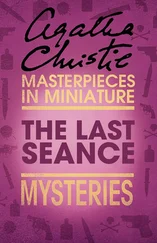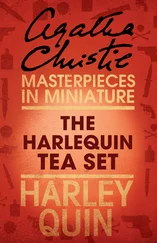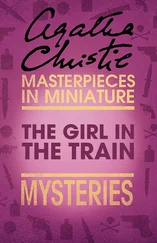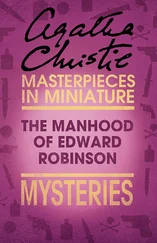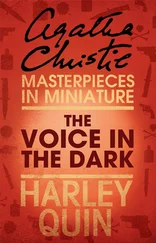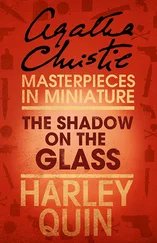In his memoirs, Sir Max Mallowan describes his wife’s Mr Quin stories as ‘detection written in a fanciful vein, touching on the fairy story, a natural product of Agatha’s peculiar imagination.’ He mentions that there is a Mr Quin story, ‘The Harlequin Tea Set’, not in The Mysterious Mr Quin, but published separately in Winter’s Crimes 3 (1971), an anthology of stories by several writers. Sir Max was apparently not aware of a fourteenth story featuring Mr Quin and Mr Satterthwaite, ‘The Love Detectives’, which finally appeared in Great Britain in Problem at Pollensa Bay and Other Stories in 1991, although it could already be found in Three Blind Mice and other stories first published in America in 1950 and sometimes reprinted as, confusingly, The Mousetrap.
In ‘The Love Detectives’, Mr Quin and Mr Satterthwaite assist Colonel Melrose (whom we remember as Chief Constable in The Secret of Chimneys and The Seven Dials Mystery) in the investigation of a murder. It is a story which fits easily into the canon, and clearly dates from the period in the twenties when most of the Quin stories were written.
The fugitive Harley Quin story mentioned by Max Mallowan, ‘The Harlequin Tea Set’, is a pendant to the series, written much later, after the Second World War, containing an oblique reference to the Mau Mau troubles in Kenya in the early 1950s. Mr Satterthwaite, ‘now of an advanced age’, has a final adventure involving Mr Quin whom he encounters, as always apparently by chance, at the Harlequin Café in a village whose name, Kingsbourne Ducis, suggests that it is in Dorset. It is many years since he last met Mr Quin: ‘A large number of years. Was it the day he had seen Mr Quin walking away from him down a country lane’ in the final story in The Mysterious Mr Quin? It was, indeed, and they were not to meet again after this single late adventure, for Mr Quin, who has now acquired a small black dog called Hermes, contrives to turn himself into a burning scarecrow at the end of the story. The supernatural has come too close for comfort.
Perhaps the most charming story in The Mysterious Mr Quin is the final one, ‘Harlequin’s Lane’, despite the fact that the author sees fit to describe one of its characters as ‘a fat Jewess with a penchant for young men of the artistic persuasion’. Mrs Christie’s fat Aryans, whatever their sexual proclivities, tend to attract their creator’s venom neither so fiercely nor so frequently. In general, however, the Mr Quin stories are both unusual and pleasantly rewarding to read. Incidentally, Mr Satterthwaite appears, without Mr Quin, in Three-Act Tragedy (1935), a Poirot novel, and ‘Dead Man’s Mirror’, one of the four long Poirot stories which make up Murder in the Mews (1937: in the USA the volume itself was called Dead Man’s Mirror, probably because ‘Mews’ is a much less familiar word in America than in England).
After its initial magazine publication, but before it had been collected into The Mysterious Mr Quin, one of the stories, ‘The Coming of Mr Quin’, was filmed in Great Britain in 1928. In addition to having its title changed to The Passing of Mr Quinn (Did the film makers fear their audiences would read a sexual connotation into ‘coming’? And why the additional ‘n’ in ‘Quinn’?), the story underwent such violent changes in the course of its adaptation for the screen that you wonder why the producers of the film bothered to acquire it in the first place. Perhaps their interest was simply in acquiring the name of Agatha Christie. Made by Strand Films, and both produced and directed by Julius Hagen, The Passing of Mr Quinn was the first British film to be made from a work by Agatha Christie. (The German film industry had got in a few months earlier, with its adaptation of The Secret Adversary . The leading roles were played by Stewart Rome, Trilby Clark and Ursula Jeans, and the script was written by Leslie Hiscott who, three years later, was to direct two Christie films, Alibi and Black Coffee .
In 1929, in a cheaply produced series, ‘The Novel Library’, 2 Конец ознакомительного фрагмента. Текст предоставлен ООО «ЛитРес». Прочитайте эту книгу целиком, купив полную легальную версию на ЛитРес. Безопасно оплатить книгу можно банковской картой Visa, MasterCard, Maestro, со счета мобильного телефона, с платежного терминала, в салоне МТС или Связной, через PayPal, WebMoney, Яндекс.Деньги, QIWI Кошелек, бонусными картами или другим удобным Вам способом.
The London Book Company published The Passing of Mr Quinn, described as ‘The book of the film adapted from a short story by Agatha Christie, novelized by G. Roy McRae’. It was prefaced by a note: ‘Readers are requested to note that Mr Quinny of this book is the same person as the Mr Quinn of the film.’ But neither Mr Quinn nor Mr Quinny is Agatha Christie’s Mr Quin, for this Quinn-Quinny reveals himself at the end to be the murderer. The victim is a Professor Appleby, who also bears little resemblance to anyone in ‘The Coming of Mr Quin’. Here is a sample of the narrative style of G. Roy McRae’s ‘novelization’:
Such was Professor Appleby, a monstrous figure of ebony and white in his dinner suit, as he wrestled under the soft-shaded lamp with the Haje snake.
There sounded all at once a slight hiss. The Haje’s long body wriggled and coiled sinuously, so that its black and white diamond markings seemed to blur. A glass vessel fell to the carpet, knocked over by the snake in its struggles, and Professor Appleby’s monocle dropped on its black cord as he smiled grimly.
In Agatha Christie’s original story, Appleton (not Appleby) has been dead for ten years, and there is no suggestion that he was given to playing with poisonous snakes when he was alive.
Black Coffee POIROT PLAY (1930)
Perhaps because of her dissatisfaction with Alibi, the play which Michael Morton had made in 1928 out of her Poirot novel The Murder of Roger Ackroyd, Agatha Christie decided to try her hand at putting Hercule Poirot on the stage in a play of her own. The result was Black Coffee. ‘It was a conventional spy thriller,’ she said of it later, ‘and although full of clichés it was not, I think, at all bad.’ She showed it to her agent, who advised her not to bother submitting it to any theatrical management, as it was not good enough to be staged. However, a friend of Mrs Christie who was connected with theatrical management thought otherwise, and Black Coffee was tried out, in 1930, at the Embassy Theatre in Swiss Cottage, London. (The Embassy is now used as a drama school.) In April the following year, it opened in the West End where it ran for a few months at the St Martin’s Theatre (where a later Christie play, The Mousetrap, was to run forever).
In 1930, Poirot had been played by Francis L. Sullivan, with John Boxer as Captain Hastings, Joyce Bland as Lucia Amory, and Donald Wolfit as Dr Carelli. 3 Конец ознакомительного фрагмента. Текст предоставлен ООО «ЛитРес». Прочитайте эту книгу целиком, купив полную легальную версию на ЛитРес. Безопасно оплатить книгу можно банковской картой Visa, MasterCard, Maestro, со счета мобильного телефона, с платежного терминала, в салоне МТС или Связной, через PayPal, WebMoney, Яндекс.Деньги, QIWI Кошелек, бонусными картами или другим удобным Вам способом.
In the West End production, Francis L. Sullivan was still Poirot, but Hastings was now played by Roland Culver, and Dr Carelli by Dino Galvani. The London Daily Telegraph thought the play a ‘sound piece of detective-story writing’, and preferred Sullivan’s rendering of the part of Poirot ‘to the one which Mr Charles Laughton gave us in Alibi. Mr Laughton’s Poirot was a diabolically clever oddity. Mr Sullivan’s is a lovable human being.’ 4 Конец ознакомительного фрагмента. Текст предоставлен ООО «ЛитРес». Прочитайте эту книгу целиком, купив полную легальную версию на ЛитРес. Безопасно оплатить книгу можно банковской картой Visa, MasterCard, Maestro, со счета мобильного телефона, с платежного терминала, в салоне МТС или Связной, через PayPal, WebMoney, Яндекс.Деньги, QIWI Кошелек, бонусными картами или другим удобным Вам способом.
Agatha Christie did not see the production. ‘I believe it came on for a short run in London,’ she wrote in 1972, ‘but I didn’t see it because I was abroad in Mesopotamia.’ 5 Конец ознакомительного фрагмента. Текст предоставлен ООО «ЛитРес». Прочитайте эту книгу целиком, купив полную легальную версию на ЛитРес. Безопасно оплатить книгу можно банковской картой Visa, MasterCard, Maestro, со счета мобильного телефона, с платежного терминала, в салоне МТС или Связной, через PayPal, WebMoney, Яндекс.Деньги, QIWI Кошелек, бонусными картами или другим удобным Вам способом.
Читать дальше
